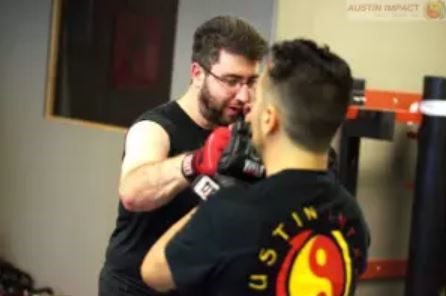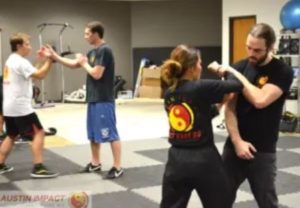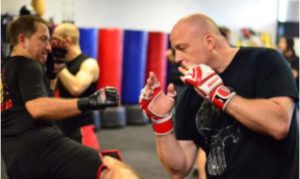Using Visualization To Achieve Success: A
WHY VISUALIZE?
Randy Couture, one of my idols, has said that, “Although most fighters believe that the fight is 90% mental and 10% physical, they train 90% physical and 10% mental. That is going to have to change…”
One of the most common methods of mental training that is touted all over the place is Visualization, or mental rehearsal. Essentially, visualization means playing things through in your head and imagining the outcome that you want.
It is used by scores of athletes and business people to reach new heights and new goals. And on some level we all do it. Before you do anything you must first create some mental picture in your mind of what that will look like.
With so much talk about the powerful benefits of visualization it seems almost surprising that so few of us use it effectively. It makes sense that, since we already visualize everything before we do it, we’d want to take control of that process in order to get the most from it.
By not taking control of our mental imagery it’s easy for our minds to wander to possible negative outcomes that leave us feeling unsure of ourselves, lacking confidence in what we can achieve. Not that this is all bad. This natural tendency is there to save our butts. If you didn’t “see” the possible negative outcomes of going 120 down the freeway during rush hour, weaving in and out of traffic, you’d probably have ended up dead or in jail by now (or on one of those ‘stupid people compilation’ videos on youtube).
But once a course of action is decided upon, it’s important to learn the skill of turning off that part of your brain that’s causing you to doubt yourself and instead switch on that part of our brain that is able to give us the confidence to go for something 100%.
To put it another way, if you’re thinking of jumping from one side of a cliff to the other side it’s useful to have a part of you that says, “Whoa! Hold on one second. Are you sure?” But once you make the jump there’s no turning back. And at that point any self-doubt only hurts your chances of making it to the other side in one piece.
THAT is where using visualization to take control of that ability to filter your inner dialogue comes in!
Visualization not only builds your ability to control your self-talk, it can also be used to develop specific skills. This is because our minds can’t fully tell the difference between an imagined event and a real one. Think of the last time you had a nightmare. You woke up, your heart pounding and your breath racing. Your body was reacting as if it was actually in danger, shooting adrenaline into your bloodstream and preparing you to fight or run. Yet nothing was actually happening. It was all in your head.
As crazy as it seems, people have actually gotten stronger just by visualizing lifting weights. Your muscle neurons fire the same whether you’re actually doing the exercise or you’re vividly imagining it (what a relief, huh? Time to cancel the gym membership ? ).
Another example is learning a new skill like hitting a baseball. If the saying “Practice makes perfect” is true, then we spend most of our time practicing messing up–missing the ball, for instance. Yet it is our mind’s ability to keep visualizing the goal of hitting the ball and to keep making subtle subconscious adjustments accordingly that makes it possible for us to develop excellence at these skills.
So learning how to consciously take control of your ability to visualize also gives you the ability to practice anything you want to learn anytime you want to practice it.
Even better, unlike actual practice, only in your mind can you do something 100% perfect. Only in your mind can you hit a home run with every swing of the bat or always make the perfect free throw.
WHY WE DON’T VISUALIZE
I’ve read about this stuff, I’ve tried this stuff, a million times. Probably so have you. But let me ask you something–do you use planned, specific visualization regularly? If not, why not?
As I’ve gone through my own experience with trying to visualize regularly, but eventually letting it fall to the wayside, and as I’ve talked to others who have tried and failed at keeping a regular schedule going with it too, I’ve found that the number one reason why visualization is so hard to keep doing is because it’s SO DAMN BORING.
I mean, we all know how useful it is. Most of us have felt its potential during our first attempts with it. But once the excitement of it wears out it gets harder and harder to keep going. It also seems to get harder and harder each time to actually “see” things in your mind so clearly that you can “feel” it in your body. This is probably also due to the boring factor–as the novelty of it wears off it gets harder and harder to stay focused on what you’re visualizing.
I’ve spent a lot of time checking out books and surfing the web, trying to find SOMETHING that would teach me the keys I needed to make visualization a natural, regular part of my training. But everything I found seemed to just talk about how great visualization is and then it would give me a general rundown of the common methods. Their advice could have all been copied and pasted from each other. There was never anything unique or particularly helpful.
So I started experimenting around with it myself. And I eventually found some key things that have helped turn the power of visualization into a regular part of my training every single day for the past 6 months.
And I want to share this with you so that you can cut through all the fluff out there and actually start putting visualization into practice for yourself.
GETTING STARTED WITH VISUALIZATION
The first thing that I decided was that I needed to develop my ability to “see” things in my mind. Easy things. I figured that our brain works like a muscle and that learning to be good at visualizing would take time.
When we give up on visualization because the mental pictures get harder and harder to create and focus on it’s often not because we suck at creating mental images and will always suck at it. No. It just means that we haven’t developed that part of our brain yet. It’d be like giving up on working out because you couldn’t bench press a 300 lb bar.
So instead, I started light. And I recommend you do the same.
I started with 10-15 mins every day (now I go for 20-25 mins at a time). I would lay down, close my eyes, and try to calm my mind by taking 10 long, deep breathes, concentrating on the feeling of the air going in and out of my lungs (this wasn’t easy and I still find my mind wandering during it. So don’t worry. Just try to calm your mind down as much as you can).
Next, I would pick something very easy to visualize. For instance, blowing up a bright colored balloon. Or standing in a room, turning the lights brighter and dimmer. Or eating a bite of lemon meringue pie one bite at a time (it’s surprising how realistic you can make it). Or getting a back massage. Or walking on the beach and jumping into the ocean (imagining the sounds, the smell of the air, anything that you would notice if you were really there).
At first that was all I’d do for my visualization sessions. And since these are easy to visualize, I never felt the frustration of not being able to imagine them. In fact, I’d finish the practice feeling refreshed and good. Just like how you feel after working out with weights that are just the right level for you.
After about 3 weeks I started building onto my visualization practice. I’d go through my previous routine in order to get my mind focused and warmed up for more detailed visualizations. Then I’d try to visualize whatever it was that I was trying to develop. Some days I could do it pretty well. Other days I just couldn’t quite capture it. Either way, though, every day I at least worked on the basics (the easy images) for 10 mins to develop that muscle.
I also finish every visualization session with a deep breath to help me mentally switch gears back into normal reality.
2 TIPS FOR VISUALIZATION SUCCESS
As I continued this practice I came to 2 conclusions:
1. There is no room for impatience. Just like warming up your muscles before a workout, there are no shortcuts. I HAD to take the time to focus my mind and get it on a creative, visual plane before I could seriously get into a good visualization session.
No matter how long you’ve been going to the gym your muscles will always require a warm-up before being ready to work. From my experience so far the same holds true for visualization.
2. Spend time feeling things in your body. A lot of times I would visualize myself performing a skill as if I were watching myself on a movie screen. However, I noticed that I felt like I got more out of it when I tried to actually picture how doing the skill felt instead of just looked. I tried to recreate the feeling inside my body.
Warming up by visualizing getting a back massage has become one of my favorite ways of priming myself to be able to “feel” what I’m visualizing rather than just “seeing” it. I’d recommend giving it a try.
WHAT TO VISUALIZE?
As far as I can tell, visualization comes down to 2 types.
1. Skill Development
2. Motivation
Skill development visualization would be anything from visualizing yourself doing a specific punch perfectly to reacting to a situation with solid confidence.
Motivation visualization would be more along the lines of seeing yourself reaching your goals and feeling what it’ll feel like or visualizing the money you’ll have and the things you’ll do when you finish a certain project at work. I don’t believe necessarily that imagining these things will “attract” them into your life on some supernatural level, but I do believe that it will refocus you and motivate you to go after them.
I tend to use both of these methods to varying degrees based on what I feel I’m needing at the moment. Motivation probably comes first, and if I’m already feeling sufficiently motivated for the day then I’ll use it for Skill Development.
HOW TO VISUALIZE?
Again, two methods:
1. Mental Rehearsal
This is where you walk through the events or the emotions, seeing and feeling them exactly as you would want them to be. It’s pretty straight forward.
2. Abstract Imagining
This is where you do things like imagining a ball of glowing confidence in the center of your chest. Or certain skills being given to you as gifts.
Both of these seem to work equally well. I think it just depends on what peaks your interest the most, since it’s your interest that makes the biggest difference in being able to see things clearly. Keep both methods in your arsenal.
VISUALIZATION AND SELF-IMAGE
As funny as it seems, even in my mind it can be challenging to see myself acting outside of my own self image (doing something in my mind that I can’t already do in real life). However, as I mentioned, you have to first see it in your mind before you can do it. If you want to become, say, more confident you must first be able to see what that would look like on you. So I’ve developed a couple of ways to help bridge that gap.
The first way is to picture myself sitting across from my ideal self, as if seeking mentoring. I picture him in as much detail as possible. I then ask him questions. This will often give me new and valuable insights.
The other way is to picture somebody else doing what I’d like to be able to do. I pay close attention to as much as I can as I watch him in my mind. Then I imagine stepping inside his body and feeling what he feels as I run through the experience again. Finally, I try to erase him in my mind and instead see myself perform whatever it is. This exercise has been quite powerful!
USING GUIDED VISUALIZATIONS
I like using guided visualizations as a way to break things up and give me a bit of a rest from having to guide it all myself. You can find tons of them on youtube. On all sorts of topics, too. (Use terms like guided meditation, self-hypnosis, etc.).
My only misgivings are that I believe they’re a bit of a crutch, meaning that if guided visualizations are relied upon too much then the visualization skills you developed will start suffering, and I also feel that they tend to be superficial. I never feel the kind of depth of experience and rewiring that I do from guiding it all myself and being able to dig deep into my own mind.
The biggest obstacle with guided visualizations is that, since they’re recordings, it’s the exact same thing over and over. This makes it very difficult, at least for me, to keep focused on the imagery after a while.
The best way to solve that problem that I’ve found is to vary it up a lot. I have a guided visualization CD that is 45 mins long. So I’ll listen to the first 20 mins one night. Then the next time I use it I’ll start it at the 5 min mark and go until the 25 min mark. The next night I use it I do the same, starting it another 5 mins further into it. This keeps me from hearing the same thing so many times that I just shut off from it.
WRITING EXERCISES AS VISUALIZATIONS
Another great way of changing up your visualization routine is to practice writing things down.
For instance:
Describe yourself and the life that you want a year from now.
When you picture yourself in X situation (perhaps one that you find stressful) what thoughts and feelings come up? (The next step is to look at those thoughts and ask yourself if they’re really true).
How would you like to handle a particular situation?
What is it about X people that you admire most?
What will you get from accomplishing your goal? What will you get if you don’t? (Tony Robbins calls this “Getting Leverage On Yourself” and it’s great for really motivating you).
I’m sure you can think of more of these types of questions.
The important thing to notice is that you can’t answer these questions without being forced to visualize.
These writing exercises are great for when you feel like you’re starting to have trouble “seeing” things in your mind.
IN CONCLUSION
I hope I have helped solve many of the problems you will deal with as you implement visualization into your own routine. More than anything, I feel that it has been my visualization routine that has kept me on track with my goals and kept me excited for the future. Try it out and don’t give up until you know if it works for you or not.
Sifu Forrest



